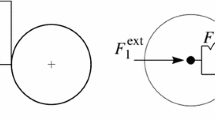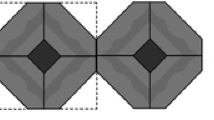Abstract
In this work, a new theoretical approach to modelling some properties of powder systems under compression is presented. This new theoretical route consists of modelling an actual powder system (with particles of unequal size and irregular form) by means of a system of deforming spheres in a simple cubic arrangement and with a certain global porosity that, in some way, makes it equivalent to the actual one. The study of the evolution of the effective contact area between particles and the effective path of the electric or thermal flow through the powder aggregate is the starting point for establishing the equivalence relationship between the actual system and the simple cubic one. In order to exemplify the utility of this new theoretical tool, two classic problems of practical interest have been studied: the electrical conduction in sintered powders and the law governing the powders’ cold die compaction. The proposed solutions to these problems, as well as the equations allowing one to obtain the equivalence relationship, are validated by experiments carried out in actual powder systems.
Similar content being viewed by others
References
R.M. German, Powder Metallurgy and Particulate Materials Processing (MPIF, Metal Powder Industries Federation, Princeton, 2005), p. 192
F.V. Lenel, Powder Metallurgy: Principles and Applications (MPIF, Metal Powder Industries Federation, Princeton, 1980)
R.M. German, Particle Packing Characteristics (MPIF, Metal Powder Industries Federation, Princeton, 1989)
R.M. German, Sintering Theory and Practice (Wiley, New York, 1996)
F. Thümmler, R. Oberacker, Introduction to Powder Metallurgy (The Institute of Materials, London, 1993)
E. Klar, Metals Handbook, Vol. 7: Powder Metallurgy, 9th edn. (ASM, American Society for Metals, Russell Township, 1984)
J. Konishi, K. Naruse, A note on fabric in terms of voids, in Micromechanics of Granular Materials, ed. by M. Satake, J.T. Jenkins (Elsevier, Amsterdam, 1998), pp. 39–46
J.W. Ross, W.A. Miller, G.C. Weatherly, Acta Metall. 30, 203–212 (1982)
A.T. Procopio, A. Zavaliangos, J. Mech. Phys. Solids 53, 1523–1551 (2005)
A. Zavaliangos, Int. J. Powder Metall. 38(2), 27–39 (2002)
PM Modnet Computer Modelling Group, Powder Metall. 42(4), 301–311 (1999)
J.M. Montes, J. Cintas, J.A. Rodríguez, E.J. Herrera, J. Mater. Sci. Lett. 22, 1669–1671 (2003)
J.M. Montes, F.G. Cuevas, J. Cintas, Comput. Mater. Sci. 36, 329–337 (2006)
J.M. Montes, F.G. Cuevas, J. Cintas, J.A. Rodríguez, E.J. Herrerra, The equivalent simple cubic system, in Trends in Materials Science Research, ed. by B.M. Caruta (Nova Science, New York, 2005), pp. 157–190
J.M. Montes, F.G. Cuevas, J. Cintas, Mater. Sci. Eng. A 395, 208–213 (2005)
J.M. Montes, F.G. Cuevas, J. Cintas, Granul. Matter 9, 401–406 (2007)
J.C. Maxwell, A Treatise on Electricity and Magnetism (Dover, New York, 1998)
H. Fricke, J. Phys. Rev. 24, 575–587 (1924)
A.L. Loeb, J. Am. Ceram. Soc. 37, 96–99 (1954)
M. Murabayashi, Y. Takahashi, T. Mukaibo, J. Nucl. Sci. Technol. 6, 657–662 (1969)
M.I. Aivazov, I.A. Domashnev, Poroshkovaya Metall. 9, 51–54 (1968) [in Russian]
R. Meyer, Powder Metall. Int. 4, 63–68 (1972)
B. Schulz, High Temp. High Press. 13, 649–660 (1981)
D.S. McLachlan, J. Phys. C, Solid State Phys. 19, 1339–1354 (1986)
M.Y. Balshin, Vestn. Metalloprom. 18(16), 124–137 (1938)
R.W. Heckel, Trans. Metall. Soc. 221, 1001–1008 (1961)
A. Kawakita, K.H. Ludde, Powder Technol. 4, 61–68 (1970)
S. Li, P.B. Khosrovabadi, B.H. Kolster, Int. J. Powder Metall. 30(1), 47–57 (1994)
R.D. Ge, Powder Metall. Sci. Technol. 6(3), 20–24 (1995)
R. Panelli, F.A. Filho, Powder Metall. 41(2), 131–133 (1998)
J. Secondi, Powder Metall. 45(3), 213–217 (2002)
MPIF Standard 46, Determination of tap density of metal powders, in Standard Test Methods for Metal Powders and Powder Metallurgy Products (MPIF, Metal Powder Industries Federation, Princeton, 2002)
A.L. Efros, Physics and Geometry of Disorder. Percolation Theory (Mir, Moscow, 1985)
D. Stauffer, A. Aharony, Introduction to Percolation Theory, 2nd edn. (Taylor & Francis, London, 1994)
J.M. Montes, F.G. Cuevas, J. Cintas, Metall. Mater. Trans. B 38(6), 957–964 (2007)
E.A. Brandes (ed.), Smithells Metals Reference Book, 6th edn. (Butterworth, London, 1983)
P. Ludwik, Elemente der Technologischen Mechanik (Springer, Berlin, 1909), p. 32
MPIF Standard 45, Determination of compressibility of metal powders, in Standard Test Methods for Metal Powders and Powder Metallurgy Products (MPIF, Metal Powder Industries Federation, Princeton, 2002)
S. Rabin, A.I. Game Programming Wisdom (Charles River Media, Princeton, 2002)
P. Lester, A * Pathfinding for Beginners. www.policyalmanac.org/games/aStarTutorial.htm (as on March 2010)
Author information
Authors and Affiliations
Corresponding author
Rights and permissions
About this article
Cite this article
Montes, J.M., Cuevas, F.G. & Cintas, J. Analytical theory for the description of powder systems under compression. Appl. Phys. A 99, 751–761 (2010). https://doi.org/10.1007/s00339-010-5682-4
Received:
Accepted:
Published:
Issue Date:
DOI: https://doi.org/10.1007/s00339-010-5682-4




